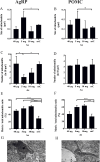Analysis of arsenic-modulated expression of hypothalamic estrogen receptor, thyroid receptor, and peroxisome proliferator-activated receptor gamma mRNA and simultaneous mitochondrial morphology and respiration rates in the mouse
- PMID: 38753618
- PMCID: PMC11098319
- DOI: 10.1371/journal.pone.0303528
Analysis of arsenic-modulated expression of hypothalamic estrogen receptor, thyroid receptor, and peroxisome proliferator-activated receptor gamma mRNA and simultaneous mitochondrial morphology and respiration rates in the mouse
Abstract
Arsenic has been identified as an environmental toxicant acting through various mechanisms, including the disruption of endocrine pathways. The present study assessed the ability of a single intraperitoneal injection of arsenic, to modify the mRNA expression levels of estrogen- and thyroid hormone receptors (ERα,β; TRα,β) and peroxisome proliferator-activated receptor gamma (PPARγ) in hypothalamic tissue homogenates of prepubertal mice in vivo. Mitochondrial respiration (MRR) was also measured, and the corresponding mitochondrial ultrastructure was analyzed. Results show that ERα,β, and TRα expression was significantly increased by arsenic, in all concentrations examined. In contrast, TRβ and PPARγ remained unaffected after arsenic injection. Arsenic-induced dose-dependent changes in state 4 mitochondrial respiration (St4). Mitochondrial morphology was affected by arsenic in that the 5 mg dose increased the size but decreased the number of mitochondria in agouti-related protein- (AgRP), while increasing the size without affecting the number of mitochondria in pro-opiomelanocortin (POMC) neurons. Arsenic also increased the size of the mitochondrial matrix per host mitochondrion. Complex analysis of dose-dependent response patterns between receptor mRNA, mitochondrial morphology, and mitochondrial respiration in the neuroendocrine hypothalamus suggests that instant arsenic effects on receptor mRNAs may not be directly reflected in St3-4 values, however, mitochondrial dynamics is affected, which predicts more pronounced effects in hypothalamus-regulated homeostatic processes after long-term arsenic exposure.
Copyright: © 2024 Alymbaeva et al. This is an open access article distributed under the terms of the Creative Commons Attribution License, which permits unrestricted use, distribution, and reproduction in any medium, provided the original author and source are credited.
Conflict of interest statement
The authors have declared that no competing interests exist.
Figures



Similar articles
-
Apoptosis Induced by the UV Filter Benzophenone-3 in Mouse Neuronal Cells Is Mediated via Attenuation of Erα/Pparγ and Stimulation of Erβ/Gpr30 Signaling.Mol Neurobiol. 2018 Mar;55(3):2362-2383. doi: 10.1007/s12035-017-0480-z. Epub 2017 Mar 29. Mol Neurobiol. 2018. PMID: 28357806 Free PMC article.
-
Peroxisome proliferator-activated receptor-gamma (PPARgamma) modulates hypothalamic Trh regulation in vivo.Mol Cell Endocrinol. 2010 Apr 12;317(1-2):44-52. doi: 10.1016/j.mce.2009.11.001. Epub 2009 Nov 10. Mol Cell Endocrinol. 2010. PMID: 19900503
-
Hormone cross-regulation in the tadpole brain: developmental expression profiles and effect of T3 exposure on thyroid hormone- and estrogen-responsive genes in Rana pipiens.Gen Comp Endocrinol. 2007 Oct-Dec;154(1-3):5-15. doi: 10.1016/j.ygcen.2007.02.011. Epub 2007 Feb 20. Gen Comp Endocrinol. 2007. PMID: 17400220
-
Co-expression of estrogen and thyroid hormone receptors in individual hypothalamic neurons.J Comp Neurol. 2001 Aug 27;437(3):286-95. doi: 10.1002/cne.1283. J Comp Neurol. 2001. PMID: 11494256
-
Neonatal imprinting and regulation of estrogen receptor alpha and beta mRNA expression by estrogen in the pituitary and hypothalamus of the male rat.Neuroendocrinology. 2001 Jan;73(1):12-25. doi: 10.1159/000054616. Neuroendocrinology. 2001. PMID: 11174013
Cited by
-
Impact of Endocrine Disruptors on the Genitourinary Tract.J Xenobiot. 2024 Dec 2;14(4):1849-1888. doi: 10.3390/jox14040099. J Xenobiot. 2024. PMID: 39728407 Free PMC article. Review.
References
-
- Ali W.; Rasool A.; Junaid M.; Zhang H. A Comprehensive Review on Current Status, Mechanism, and Possible Sources of Arsenic Contamination in Groundwater: A Global Perspective with Prominence of Pakistan Scenario. Environ. Geochem. Health 2019, 41, 737–760. doi: 10.1007/s10653-018-0169-x - DOI - PubMed
-
- Mukherjee A.; Sarkar S.; Coomar P.; Bhattacharya P. Towards Clean Water: Managing Risk of Arsenic-Contaminated Groundwater for Human Consumption. Curr. Opin. Environ. Sci. Heal. 2023, 36, 100509, doi: 10.1016/j.coesh.2023.100509 - DOI
MeSH terms
Substances
LinkOut - more resources
Full Text Sources
Medical
Miscellaneous

